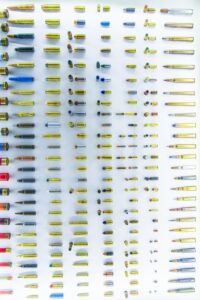 In forensic science, the study of ballistics is the study of motion, dynamics, angular movement, and effects of projectile units (bullets, missiles, and bombs). There are many applications of ballistics within a criminal investigation.
In forensic science, the study of ballistics is the study of motion, dynamics, angular movement, and effects of projectile units (bullets, missiles, and bombs). There are many applications of ballistics within a criminal investigation.
Bullets that are fired at the scene of a crime will be examined in the hopes of discovering several pieces of information. The actual bullets can identify what type of gun the criminal used and whether or not the firearm is connected to any other crime. The amount of damage a bullet has sustained upon hitting a hard surface can help determine approximately where the shooter was standing, what angle the gun was fired from, and when the gun was fired. Any residue on the bullet can be studied and compared to residue on the hand of a suspect, the gun that was fired, or any object that was close by when the firearm was used. This information helps researchers uncover the identity of the shooter. When the bullets are missing, the type of impact they made can still lead investigators to ascertain what kind of bullet the criminal used, and therefore the type of gun as well.
Studying the markings found on a bullet or the impact a bullet made on any surface can establish exactly which gun the criminal used. Every firearm produces a slightly different and unique pattern on the shell-casing it fires; the bullet will therefore imprint a distinct pattern upon anything it hits. Once scientists have identified these markings they can easily match them to the appropriate firearm.
There are many experts deeply involved in this study, and they are frequently called upon to help solve crimes. Ballistics details are also commonly input into a large database that can be accessed by law enforcement agencies all across the country. When someone enters new data, the computer locates any relevant data from previous investigations. This information can lead to the discovery of the owner of a particular weapon, and assist in tracking down the guilty party who fired the gun.
Back to Crime Library
|
|
|
